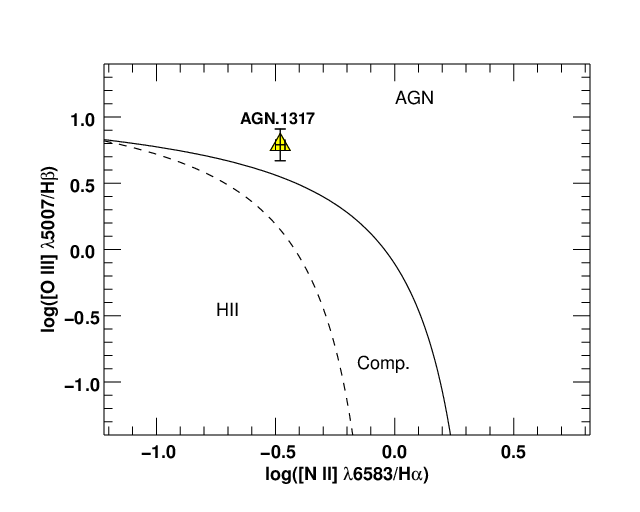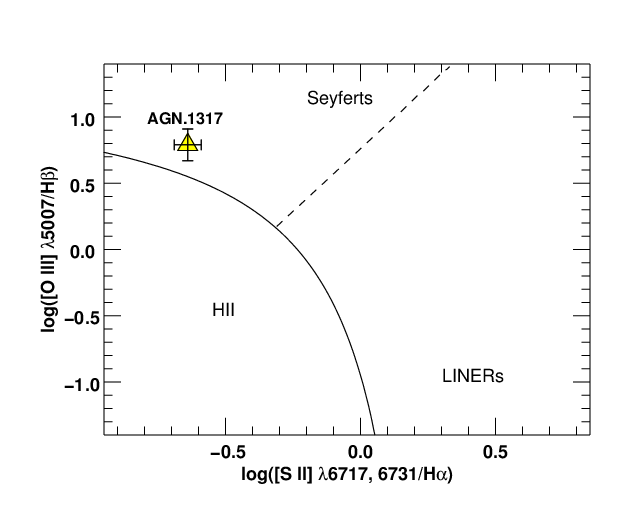A protocluster of galaxies at z ~ 1.4 observed with LBT
Galaxy clusters provide an efficient tool for deriving cosmological parameters and for studying galaxy formation and evolution. A technique for detecting galaxy clusters at z > 1 has been to look at the immediate surroundings of high-redshift radio galaxies. An important aspect in the study of clusters is the demographics and distribution of the active galactic nuclei (AGN) within clusters and their evolution with redshift. The AGN population of a cluster has indeed important implications for the AGN fueling processes and how tightly black holes at the centers of cluster galaxies and galaxies coevolve.
In this scientific framework, a group of researchers -led by Viviana Casasola and including Laura Magrini and Simone Bianchi of the Arcetri Observatory- has recently published a paper on the spectroscopic study of 13 galaxies identified in the field of the protocluster associated with the radio galaxy 7C 1756+6520 at z = 1.4156 (Casasola et al. 2018). This work, stimulated by previous results obtained for this protocluster (Magrini et al. 2012, Casasola et al. 2013), has been performed on rest-frame optical spectra taken with the Large Binocular Telescope (LBT). The adopted spectral coverage allowed to observe emission lines such as Hα, Hβ, [O III]5007 Å, and [N II]6583 Å at the redshift of the central radio galaxy.
With these LBT observations, Casasola et al. (2018) derived the redshift by detecting emission lines that have never detected before for these galaxies. They also identified a new protocluster member and eight new possible protocluster members. These galaxies are now identified with the name CMC [Casasola, Magrini, Combes, from the names of the first three authors of the paper] followed by a number. Figure 1 shows the spatial distribution of the sources Casasola et al. (2018) detected in the field of the protocluster 7C 1756+6520 (left panel) and of all the galaxies spectroscopically confirmed members of the galaxy overdensity (right panel).

Figure 1: Left panel: Galaxies detected by Casasola et al. (2018) in the field of the overdensity around the radio galaxy 7C 1756+6520 plotted on the B-band image (NOAO). The five colors and symbols indicate different ranges of redshift. The central radio galaxy 7C 1756+6520 is the big yellow star in the center. Right panel: All protocluster and possible protocluster members with spectroscopically confirmed redshift from this work and the literature. The circle indicates a distance of 2 Mpc from the central radio galaxy.
The stacked spectrum of the galaxies in which Casasola et al. (2018) detected the [O III]5007 Å emission line, shown in Figure 2, revealed the presence of the second line of the [O III] doublet at 4959 Å and of Hβ. Additionally, the ratio between the two lines of the [O III] doublet is consistent with the theoretical value of ~3, confirming that these galaxies belong to the protocluster.

Figure 2: 1D stacked rest-frame spectrum in the J-LBT wavelength range of the possible protocluster members where Casasola et al. (2018) detected the [O III]5007 Å line.
A peculiar property of this protocluster is its AGN fraction, which at 23% is higher than what typically characterizes low-, moderate- and high-redshift clusters. The high AGN fraction and distribution of AGN within the protocluster seem to be broadly consistent with predictions of some theoretical models on the AGN feedback, based on galaxy interactions and ram pressure.
For one protocluster AGN (AGN.1317), Casasola et al. (2018) also confirmed, for the first time through two “Baldwin, Phillips & Terlevich” (BPT) diagrams, that it hosts an AGN. This finding is illustrated in Figure 3.


Figure 3: The [N II]/Hα vs. [O III]/Hβ (left panel) and [S II]/Hα vs. [O III]/Hβ (right panel) BPT diagrams showing the location of AGN.1317 (yellow triangle).
Observations of AGN in this protocluster and in other distant clusters will help clarifying whether the resulting high fraction of AGN is unusual or typical for such structures at high redshift.
References:
Casasola et al. (2018), A&A, in press



